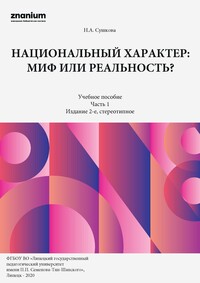Национальный характер: миф или реальность. Часть 1
Покупка
Тематика:
Английский язык
Издательство:
ЛГПУ имени П. П. Семёнова-Тян-Шанского
Автор:
Сушкова Наталья Алексеевна
Год издания: 2020
Кол-во страниц: 68
Возрастное ограничение: 16+
Дополнительно
Вид издания:
Учебное пособие
Уровень образования:
ВО - Бакалавриат
ISBN: 978-5-907168-93-0
Артикул: 835341.01.99
Целью данного пособия является развитие языковой, речевой и социокультурной компетенции в ходе обсуждения вопросов национальной идентичности, проблем межкультурной коммуникации. Основу составляют оригинальные тексты, которые освещают взаимоотношения между представителями разных наций, особенности национального характера англичан, американцев, русских. Каждый текст сопровождается упражнениями, вопросами для обсуждения, заданиями проектного характера. Данное пособие предназначено для студентов, обучающихся по направлению 45.03.02 Лингвистика (Теория и методика преподавания иностранных языков и культур), изучающих английский как основной иностранный язык и владеющих им на уровне B2 или C1 (Upper-Intermediate или Advanced). Рекомендовано для слушателей программ до-полнительного профессионального образования соответствующего направления подготовки.
Скопировать запись
Фрагмент текстового слоя документа размещен для индексирующих роботов
Н.А. Сушкова НАЦИОНАЛЬНЫЙ ХАРАКТЕР: МИФ ИЛИ РЕАЛЬНОСТЬ? Учебное пособие Часть 1 Издание 2-е, стереотипное Липецк – 2020
МИНИСТЕРСТВО ПРОСВЕЩЕНИЯ РОССИЙСКОЙ ФЕДЕРАЦИИ ФЕДЕРАЛЬНОЕ ГОСУДАРСТВЕННОЕ БЮДЖЕТНОЕ ОБРАЗОВАТЕЛЬНОЕ УЧРЕЖДЕНИЕ ВЫСШЕГО ОБРАЗОВАНИЯ «ЛИПЕЦКИЙ ГОСУДАРСТВЕННЫЙ ПЕДАГОГИЧЕСКИЙ УНИВЕРСИТЕТ ИМЕНИ П.П. СЕМЕНОВА-ТЯН-ШАНСКОГО» ИНСТИТУТ ФИЛОЛОГИИ Кафедра лингвистики и межкультурной коммуникации Н.А. Сушкова National Character: Myth or Reality? Учебное пособие Часть 1 Издание 2-е, стереотипное Липецк – 2020
МИНИСТЕРСТВО ПРОСВЕЩЕНИЯ РОССИЙСКОЙ ФЕДЕРАЦИИ ФЕДЕРАЛЬНОЕ ГОСУДАРСТВЕННОЕ БЮДЖЕТНОЕ ОБРАЗОВАТЕЛЬНОЕ УЧРЕЖДЕНИЕ ВЫСШЕГО ОБРАЗОВАНИЯ «ЛИПЕЦКИЙ ГОСУДАРСТВЕННЫЙ ПЕДАГОГИЧЕСКИЙ УНИВЕРСИТЕТ ИМЕНИ П.П. СЕМЕНОВА-ТЯН-ШАНСКОГО» ИНСТИТУТ ФИЛОЛОГИИ Кафедра лингвистики и межкультурной коммуникации Н.А. СУШКОВА НАЦИОНАЛЬНЫЙ ХАРАКТЕР: МИФ ИЛИ РЕАЛЬНОСТЬ? Часть 1 Учебное пособие Издание 2-е, стереотипное Липецк – 2020
УДК 43 ББК 81.432.1-7 С 89 Печатается по решению кафедры лингвистики и межкультурной коммуникации ФГБОУ ВО ЛГПУ имени П.П. Семенова-Тян-Шанского Протокол № 9 от 24.04.2020 г. Сушкова, Н.А. Национальный характер: миф или реальность: учебное пособие / Н.А. Сушкова. – Липецк: ЛГПУ имени П.П. Семенова-Тян-Шанского, 2020. – Издание 2-е, стереотипное – Часть 1. – 68 с. – Текст непосредственный. ISBN 978-5-907168-93-0 (Ч. 1) ISBN 978-5-907168-91-6 Целью данного пособия является развитие языковой, речевой и социокультурной компетенции в ходе обсуждения вопросов национальной идентичности, проблем межкультурной коммуникации. Основу составляют оригинальные тексты, которые освещают взаимоотношения между представителями разных наций, особенности национального характера англичан, американцев, русских. Каждый текст сопровождается упражнениями, вопросами для обсуждения, заданиями проектного характера. Данное пособие предназначено для студентов, обучающихся по направлению 45.03.02 Лингвистика (Теория и методика преподавания иностранных языков и культур), изучающих английский как основной иностранный язык и владеющих им на уровне B2 или C1 (Upper-Intermediate или Advanced). Рекомендовано для слушателей программ дополнительного профессионального образования соответствующего направления подготовки. УДК 43 ББК 81.432.1-7 С 89 РЕЦЕНЗЕНТЫ: Ю.В. Маслова, канд. пед. наук, доцент ЛГПУ имени П.П. Семенова-Тян-Шанского Н.В. Барышев, канд. филол. наук, заведующий кафедрой иностранных языков ЛГТУ ISBN 978-5-907168-93-0 (Ч. 1) © ФГБОУ ВО «Липецкий государственный ISBN 978-5-907168-91-6 педагогический университет имени П.П. Семенова-Тян-Шанского», 2020 © Н.А. Сушкова, 2020
UNIT ONE: NATIONALITY STEREOTYPES Stereotypes: Where do They Root from? 1. Introductory talk. National stereotypes have been the subject of many discussions for centuries. Even today when the international community promotes diversity and encourages tolerance, certain people are still tagged accord ing to their nationalities. What is a stereotype? Can you give any examples? Can stereotypes be useful in any sit uations? What are the negative consequences of a stereotypical way of thinking? Where do stereotypes root from? 2. Read what scientists think about psychological roots of stereotypes and say why you think stereotypes are so difficult to change. A set of beliefs or traits that we attribute to a particular group of people is called stereotypes. Stereotypes tend to be extreme, are most often negative and false. Psychologists believe that we develop stereotypes when parents, peers, co-workers, teachers and others reward us with approval for holding certain attitudes and beliefs. Due to stereotypes your future perception of any phenomenon will be biased. Researchers find that we overestimate the number of times we have observed a situation that matches our stereotype. This means that if you hold a stereotype of the black as lacking motivation, you will overestimate the number of times you have ob served the black not working. The result of it is that your stereotypes are confirmed and will persist. Besides, you underestimate the number of times you’ve observed the situation that doesn’t match you stereotype. Stereotypes remain very difficult to change.
3. Read the names of the countries and find them on the map. What do you call the people of these countries? Do you have any stereotypes connected with them? Switzerland, India, Japan, Scotland, Italy, the United States, Russia, Egypt, Greece, Germany, France, the United Kingdom Focus on Grammar: Articles with names of countries and nationalities Names of countries are used without articles. E.g. France, Japan. But we use the definite article in names with words “republic”, “kingdom”, “states” etc. E.g. the United States of America, the Dominican Republic. The definite article is also used if the name of the country is a plural noun. E.g. the Netherlands. You can use the with some nationality adjectives to mean “people of that country”. E.g. The French are famous for their food. In the same way you can say: the Spanish, the Dutch, the British, the Irish, the Welsh. Note that the French/ the English etc. are plural in meaning. You cannot say ‘a French/ an English”. You have to say “a Frenchman/ a Frenchwoman” etc. You can also use the + nationality words ending in -ese (the Chinese/ the Su danese etc.). E.g. The Chinese invented printing. These words can also be singular (a Japanese/ a Sudanese). Also: the Swiss/ a Swiss (plural or singular). With other nationalities, the plural noun ends in -s. E.g. an Italian/ the Italians, a Mexican/ the Mexicans, a Scot/ the Scots, a Turk/ the Turks. [8] 4. Which stereotype do you think is the most widely-spread? the most amazing? the silliest? Give a short talk about the most widely-spread stereotype using the ta ble. 5. Listen to the conversation between two people of different nationalities. Write down the script. Learn it by heart and act it out.


